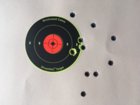QuickLoad will show a pretty much linear response of change in velocity with respect to case volume variance (i.e. change in seating depth, using a longer/shorter Lot of bullets, high/low case volume within a single Lot# of brass). However, for very small changes in effective case volume such as are observed with successive seating depth increments, the actual change in velocity is typically smaller than the SD for a 5-shot group meaning, effectively, it's not a statistically different value. For example, if two individual 5-shot group average velocities differ by 6 fps, but the ES/SD for each group is 20fps /7.0 fps, the two average velocities are not statistically different. It's pretty easy to discern when two (or more) average velocity values are actually statistically different. In my hands, changing the seating depth of [jumped] bullets in .223 Rem or .308 Win cases by as much as .010" in either direction generally doesn't cause a statistically significant change in velocity. If you change the seating depth by approximately .030" or more, the change in velocity starts to become statistically significant.
Clearly, if you're changing the internal case volume, regardless of the mechanism (i.e. changing seating depth, bullet length, etc.), pressure will change, and, by extension, velocity will change. However, there are additional factors such as the accuracy of most chronographs, accuracy of charge weight measurement, bullet weight, neck tension, small sample size (i.e. 5 shots or less), barrel heating, powder selection, primer selection...the list goes on and on, that also affect average velocity measurements. When case volume variance becomes so large as to outweigh the other major factors that introduce velocity variance, it will start to show up as a larger change in velocity between sample sets than the SD of an individual velocity sample set. IMO - small changes in case volume (i.e. +/- 0.1 or 0.2 gr) are not typically the cause of large variance in average velocity. It is usually due to one of the other factors. Case volume variance of ~0.3 - 0.5 gr (or more) starts to become noticeable with a typical chronograph. Again, the smaller the case, the larger the potential effect on velocity of a given case volume variance. Also critical is the intended purpose - some disciplines are clearly less tolerant of case volume/velocity variance than others.
As I mentioned above, if you think case volume variance might be a concern, the simplest and most direct way to test it is to select a few cases (i.e. ~5 or more) from the extremes (high/low volume), load them up identically, and go measure velocity. If the case volume variance is sufficient to give you average velocity values that are statistically different (i.e. - the difference between the two average velocities is greater than the SDs of the two individual sets), then you may want to start sorting cases into groups with smaller volume variance.












